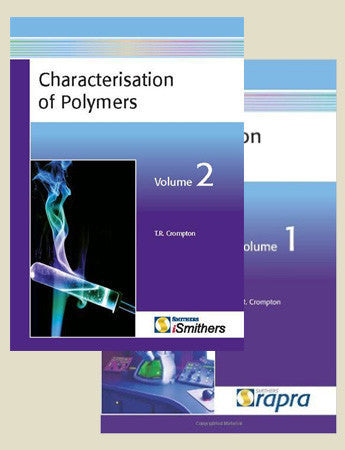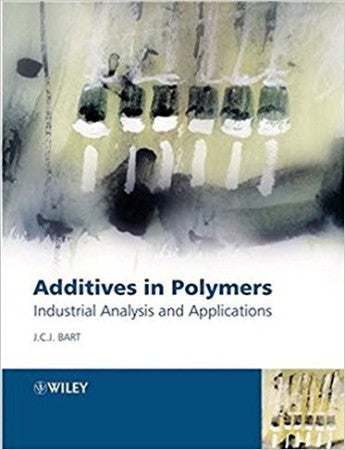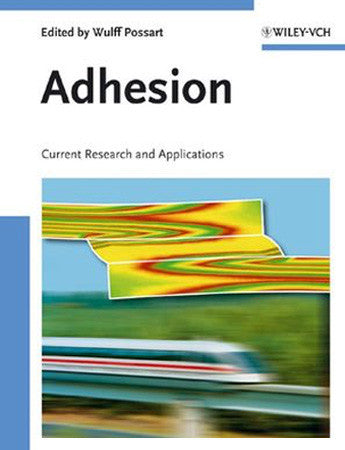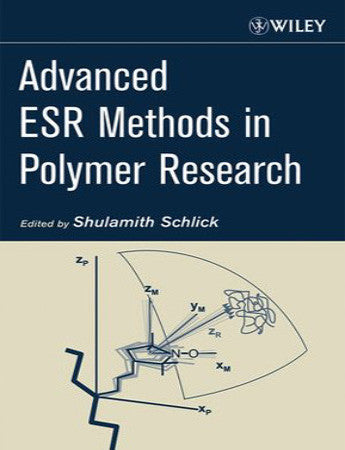Characterisation of Polymers, Volume 1 & 2
Volume 1 covers the methodology used for the determination of metals, non-metals and organic functional groups in polymers, and for the determination of the ratio in which different monomer units occur in copolymers. The techniques available for composition determination of homopolymers and copolymers and other recent modern techniques such as X-ray photoelectron spectroscopy, atomic force microscopy, microthermal analysis and scanning electron microscopy and energy dispersive analysis using X-rays are also included.The structure and microstructure of polymers, copolymers and rubbers are dealt with in Volume 2. More detailed aspects, such as sequencing of monomer units in copolymers, end-group analysis, tacticity and stereochemical determinations, are also dealt with in this subsequent volume.
VOLUME 1
VOLUME 2
Volume 1 covers the methodology used for the determination of metals, non-metals and organic functional groups in polymers, and for the determination of the ratio in which different monomer units occur in copolymers. The techniques available for composition determination of homopolymers and copolymers and other recent modern techniques such as X-ray photoelectron spectroscopy, atomic force microscopy, microthermal analysis and scanning electron microscopy and energy dispersive analysis using X-rays are also included.The structure and microstructure of polymers, copolymers and rubbers are dealt with in Volume 2. More detailed aspects, such as sequencing of monomer units in copolymers, end-group analysis, tacticity and stereochemical determinations, are also dealt with in this subsequent volume.
VOLUME 1
VOLUME 2
Related Products
Additives in Polymers:...
$550.00
{"id":11242200772,"title":"Additives in Polymers: Industrial Analysis and Applications","handle":"978-0-470-85062-6","description":"\u003ch5\u003eDescription\u003c\/h5\u003e\nAuthor: Jan C. J. Bart \u003cbr\u003eISBN 978-0-470-85062-6 \u003cbr\u003e\u003cbr\u003epages 836 Hardcover\n\u003ch5\u003eSummary\u003c\/h5\u003e\nThis industrially relevant resource covers all established and emerging analytical methods for the deformulation of polymeric materials, with emphasis on the non-polymeric components. \u003cbr\u003e\n\u003cul\u003e\n\u003cli\u003eEach technique is evaluated on its technical and industrial merits.\u003c\/li\u003e\n\u003cli\u003eEmphasis is on understanding (principles and characteristics) and industrial applicability.\u003c\/li\u003e\n\u003cli\u003eExtensively illustrated throughout with over 200 figures, 400 tables, and 3,000 references.\u003c\/li\u003e\n\u003c\/ul\u003e\n\u003cbr\u003e\n\u003ch5\u003eTable of Contents\u003c\/h5\u003e\n\u003cbr\u003eForeword. \u003cbr\u003ePreface. \u003cbr\u003eAbout the Author. \u003cbr\u003eAcknowledgements. \u003cbr\u003eChapter 1: Introduction. \u003cbr\u003e1.1 Additives. \u003cbr\u003e1.2 Plastics formulations . \u003cbr\u003e1.3 Economic impact of polymer additives. \u003cbr\u003e1.4 Analysis of plastics. \u003cbr\u003e1.5 Bibliography. \u003cbr\u003e1.6 References. \u003cbr\u003eChapter 2: Deformulation Principles. \u003cbr\u003e2.1 Polymer identification. \u003cbr\u003e2.2 Additive analysis of rubbers: ‘Best Practice’. \u003cbr\u003e2.3 Polymer extract analysis. \u003cbr\u003e2.4 In situ polymer\/additive analysis. \u003cbr\u003e2.5 Class-specific polymer\/additive analysis. \u003cbr\u003e2.6 Bibliography. \u003cbr\u003e2.7 References. \u003cbr\u003eChapter 3: Sample Preparation Perspectives. \u003cbr\u003e3.1 Solvents. \u003cbr\u003e3.2 Extraction strategy. \u003cbr\u003e3.3 Conventional extraction technologies. \u003cbr\u003e3.4 High-pressure solvent extraction methods. \u003cbr\u003e3.5 Sorbent extraction. \u003cbr\u003e3.6 Methodological comparison of extraction methods. \u003cbr\u003e3.7 Polymer\/additive dissolution methods. \u003cbr\u003e3.8 Hydrolysis. \u003cbr\u003e3.9 Bibliography. \u003cbr\u003e3.10 References. \u003cbr\u003eChapter 4: Separation Techniques. \u003cbr\u003e4.1 Analytical detectors. \u003cbr\u003e4.2 Gas chromatography. \u003cbr\u003e4.3 Supercritical fluid chromatography. \u003cbr\u003e4.4 Liquid chromatography techniques. \u003cbr\u003e4.5 Capillary electrophoretic techniques. \u003cbr\u003e4.6 Bibliography. \u003cbr\u003e4.7 References. \u003cbr\u003eChapter 5: Polymer\/Additive Analysis: The Spectroscopic Alternative. \u003cbr\u003e5.1 Ultraviolet\/visible spectrophotometry. \u003cbr\u003e5.2 Infrared spectroscopy. \u003cbr\u003e5.3 Luminescence spectroscopy. \u003cbr\u003e5.4 High-resolution nuclear magnetic resonance spectroscopy. \u003cbr\u003e5.5 Bibliography. \u003cbr\u003e5.6 References. \u003cbr\u003eChapter 6: Organic Mass-Spectrometric Methods. \u003cbr\u003e6.1 Basic instrumentation. \u003cbr\u003e6.2 Ion sources. \u003cbr\u003e6.3 Mass analysers. \u003cbr\u003e6.4 Direct mass-spectrometric polymer compound analysis. \u003cbr\u003e6.5 Ion mobility spectrometry. \u003cbr\u003e6.6 Bibliography. \u003cbr\u003e6.7 References. \u003cbr\u003eChapter 7: Multihyphenation and Multidimensionality in Polymer\/Additive Analysis. \u003cbr\u003e7.1 Precolumn hyphenation. \u003cbr\u003e7.2 Coupled sample preparation – spectroscopy\/spectrometry. \u003cbr\u003e7.3 Postcolumn hyphenation. \u003cbr\u003e7.4 Multidimensional chromatography. \u003cbr\u003e7.5 Multidimensional spectroscopy. \u003cbr\u003e7.6 Bibliography. \u003cbr\u003e7.7 References. \u003cbr\u003eChapter 8: Inorganic and Element Analytical Methods. \u003cbr\u003e8.1 Element analytical protocols. \u003cbr\u003e8.2 Sample destruction for classical elemental analysis. \u003cbr\u003e8.3 Analytical atomic spectrometry. \u003cbr\u003e8.4 X-ray spectrometry. \u003cbr\u003e8.5 Inorganic mass spectrometry. \u003cbr\u003e8.6 Radioanalytical and nuclear analytical methods. \u003cbr\u003e8.7 Electroanalytical techniques. \u003cbr\u003e8.8 Solid-state speciation analysis. \u003cbr\u003e8.9 Bibliography. \u003cbr\u003e8.10 References. \u003cbr\u003eChapter 9: Direct Methods of Deformulation of Polymer\/Additive Dissolutions. \u003cbr\u003e9.1 Chromatographic methods. \u003cbr\u003e9.2 Spectroscopic techniques. \u003cbr\u003e9.3 Mass-spectrometric methods. \u003cbr\u003e9.4 References. \u003cbr\u003eChapter 10: A Vision for the Future. \u003cbr\u003e10.1 Trends in polymer technology. \u003cbr\u003e10.2 Trends in additive technology. \u003cbr\u003e10.3 Environmental, legislative and regulatory constraints. \u003cbr\u003e10.4 Analytical consequences. \u003cbr\u003e10.5 Epilogue. \u003cbr\u003e10.6 Bibliography. \u003cbr\u003e10.7 References. \u003cbr\u003eAppendix I: List of Symbols. \u003cbr\u003eAppendix II: Functionality of Common Additives Used in Commercial Thermoplastics, Rubbers, and Thermosetting Resins. \u003cbr\u003eAppendix III: Specimen Polymer Additives Product Sheets. \u003cbr\u003eIndex. \u003cbr\u003e\u003cbr\u003e\n\u003ch5\u003eAbout Author\u003c\/h5\u003e\n\u003cb\u003eJan C.J. Bart\u003c\/b\u003e (Ph.D. Structural Chemistry, University of Amsterdam) is a senior scientist with a broad interest in materials characterisation, heterogeneous catalysis and product development who spent an industrial career in R\u0026amp;D with Monsanto, Montedison and DSM Research in various countries. The author has held several teaching assignments and researched extensively in both academic and industrial areas; he authored over 250 scientific papers, including chapters in books. Dr. Bart has acted as a Ramsay Memorial Fellow at the Universities of Leeds (Colour Chemistry) and Oxford (Material Science), a visiting scientist at Institut de Recherches sur la Catalyse (CNRS, Villeurbanne), and a Meyerhoff Visiting Professor at WIS (Rehovoth), and held an Invited Professorship at USTC (Hefei). He is currently a Full Professor of Industrial Chemistry at the University of Messina. He is also a member of the Royal Society of Chemistry, Royal Dutch Chemical Society, Society of Plastic Engineers and The Institute of Materials.","published_at":"2017-06-22T21:12:39-04:00","created_at":"2017-06-22T21:12:39-04:00","vendor":"Chemtec Publishing","type":"Book","tags":["2005","additives","book","extraction","fillers","Gas chromatography. supercritical fluid chromatography","hydrolisis","liquid chromatography","p-chemical","plastic","plastics","polymer","rubber","solvents","spectroscopy. radioanalytical"],"price":55000,"price_min":55000,"price_max":55000,"available":true,"price_varies":false,"compare_at_price":null,"compare_at_price_min":0,"compare_at_price_max":0,"compare_at_price_varies":false,"variants":[{"id":43378306308,"title":"Default Title","option1":"Default Title","option2":null,"option3":null,"sku":"","requires_shipping":true,"taxable":true,"featured_image":null,"available":true,"name":"Additives in Polymers: Industrial Analysis and Applications","public_title":null,"options":["Default Title"],"price":55000,"weight":1000,"compare_at_price":null,"inventory_quantity":1,"inventory_management":null,"inventory_policy":"continue","barcode":"978-0-470-85062-6","requires_selling_plan":false,"selling_plan_allocations":[]}],"images":["\/\/chemtec.org\/cdn\/shop\/products\/978-0-470-85062-6.jpg?v=1499914044"],"featured_image":"\/\/chemtec.org\/cdn\/shop\/products\/978-0-470-85062-6.jpg?v=1499914044","options":["Title"],"media":[{"alt":null,"id":350139580509,"position":1,"preview_image":{"aspect_ratio":0.767,"height":450,"width":345,"src":"\/\/chemtec.org\/cdn\/shop\/products\/978-0-470-85062-6.jpg?v=1499914044"},"aspect_ratio":0.767,"height":450,"media_type":"image","src":"\/\/chemtec.org\/cdn\/shop\/products\/978-0-470-85062-6.jpg?v=1499914044","width":345}],"requires_selling_plan":false,"selling_plan_groups":[],"content":"\u003ch5\u003eDescription\u003c\/h5\u003e\nAuthor: Jan C. J. Bart \u003cbr\u003eISBN 978-0-470-85062-6 \u003cbr\u003e\u003cbr\u003epages 836 Hardcover\n\u003ch5\u003eSummary\u003c\/h5\u003e\nThis industrially relevant resource covers all established and emerging analytical methods for the deformulation of polymeric materials, with emphasis on the non-polymeric components. \u003cbr\u003e\n\u003cul\u003e\n\u003cli\u003eEach technique is evaluated on its technical and industrial merits.\u003c\/li\u003e\n\u003cli\u003eEmphasis is on understanding (principles and characteristics) and industrial applicability.\u003c\/li\u003e\n\u003cli\u003eExtensively illustrated throughout with over 200 figures, 400 tables, and 3,000 references.\u003c\/li\u003e\n\u003c\/ul\u003e\n\u003cbr\u003e\n\u003ch5\u003eTable of Contents\u003c\/h5\u003e\n\u003cbr\u003eForeword. \u003cbr\u003ePreface. \u003cbr\u003eAbout the Author. \u003cbr\u003eAcknowledgements. \u003cbr\u003eChapter 1: Introduction. \u003cbr\u003e1.1 Additives. \u003cbr\u003e1.2 Plastics formulations . \u003cbr\u003e1.3 Economic impact of polymer additives. \u003cbr\u003e1.4 Analysis of plastics. \u003cbr\u003e1.5 Bibliography. \u003cbr\u003e1.6 References. \u003cbr\u003eChapter 2: Deformulation Principles. \u003cbr\u003e2.1 Polymer identification. \u003cbr\u003e2.2 Additive analysis of rubbers: ‘Best Practice’. \u003cbr\u003e2.3 Polymer extract analysis. \u003cbr\u003e2.4 In situ polymer\/additive analysis. \u003cbr\u003e2.5 Class-specific polymer\/additive analysis. \u003cbr\u003e2.6 Bibliography. \u003cbr\u003e2.7 References. \u003cbr\u003eChapter 3: Sample Preparation Perspectives. \u003cbr\u003e3.1 Solvents. \u003cbr\u003e3.2 Extraction strategy. \u003cbr\u003e3.3 Conventional extraction technologies. \u003cbr\u003e3.4 High-pressure solvent extraction methods. \u003cbr\u003e3.5 Sorbent extraction. \u003cbr\u003e3.6 Methodological comparison of extraction methods. \u003cbr\u003e3.7 Polymer\/additive dissolution methods. \u003cbr\u003e3.8 Hydrolysis. \u003cbr\u003e3.9 Bibliography. \u003cbr\u003e3.10 References. \u003cbr\u003eChapter 4: Separation Techniques. \u003cbr\u003e4.1 Analytical detectors. \u003cbr\u003e4.2 Gas chromatography. \u003cbr\u003e4.3 Supercritical fluid chromatography. \u003cbr\u003e4.4 Liquid chromatography techniques. \u003cbr\u003e4.5 Capillary electrophoretic techniques. \u003cbr\u003e4.6 Bibliography. \u003cbr\u003e4.7 References. \u003cbr\u003eChapter 5: Polymer\/Additive Analysis: The Spectroscopic Alternative. \u003cbr\u003e5.1 Ultraviolet\/visible spectrophotometry. \u003cbr\u003e5.2 Infrared spectroscopy. \u003cbr\u003e5.3 Luminescence spectroscopy. \u003cbr\u003e5.4 High-resolution nuclear magnetic resonance spectroscopy. \u003cbr\u003e5.5 Bibliography. \u003cbr\u003e5.6 References. \u003cbr\u003eChapter 6: Organic Mass-Spectrometric Methods. \u003cbr\u003e6.1 Basic instrumentation. \u003cbr\u003e6.2 Ion sources. \u003cbr\u003e6.3 Mass analysers. \u003cbr\u003e6.4 Direct mass-spectrometric polymer compound analysis. \u003cbr\u003e6.5 Ion mobility spectrometry. \u003cbr\u003e6.6 Bibliography. \u003cbr\u003e6.7 References. \u003cbr\u003eChapter 7: Multihyphenation and Multidimensionality in Polymer\/Additive Analysis. \u003cbr\u003e7.1 Precolumn hyphenation. \u003cbr\u003e7.2 Coupled sample preparation – spectroscopy\/spectrometry. \u003cbr\u003e7.3 Postcolumn hyphenation. \u003cbr\u003e7.4 Multidimensional chromatography. \u003cbr\u003e7.5 Multidimensional spectroscopy. \u003cbr\u003e7.6 Bibliography. \u003cbr\u003e7.7 References. \u003cbr\u003eChapter 8: Inorganic and Element Analytical Methods. \u003cbr\u003e8.1 Element analytical protocols. \u003cbr\u003e8.2 Sample destruction for classical elemental analysis. \u003cbr\u003e8.3 Analytical atomic spectrometry. \u003cbr\u003e8.4 X-ray spectrometry. \u003cbr\u003e8.5 Inorganic mass spectrometry. \u003cbr\u003e8.6 Radioanalytical and nuclear analytical methods. \u003cbr\u003e8.7 Electroanalytical techniques. \u003cbr\u003e8.8 Solid-state speciation analysis. \u003cbr\u003e8.9 Bibliography. \u003cbr\u003e8.10 References. \u003cbr\u003eChapter 9: Direct Methods of Deformulation of Polymer\/Additive Dissolutions. \u003cbr\u003e9.1 Chromatographic methods. \u003cbr\u003e9.2 Spectroscopic techniques. \u003cbr\u003e9.3 Mass-spectrometric methods. \u003cbr\u003e9.4 References. \u003cbr\u003eChapter 10: A Vision for the Future. \u003cbr\u003e10.1 Trends in polymer technology. \u003cbr\u003e10.2 Trends in additive technology. \u003cbr\u003e10.3 Environmental, legislative and regulatory constraints. \u003cbr\u003e10.4 Analytical consequences. \u003cbr\u003e10.5 Epilogue. \u003cbr\u003e10.6 Bibliography. \u003cbr\u003e10.7 References. \u003cbr\u003eAppendix I: List of Symbols. \u003cbr\u003eAppendix II: Functionality of Common Additives Used in Commercial Thermoplastics, Rubbers, and Thermosetting Resins. \u003cbr\u003eAppendix III: Specimen Polymer Additives Product Sheets. \u003cbr\u003eIndex. \u003cbr\u003e\u003cbr\u003e\n\u003ch5\u003eAbout Author\u003c\/h5\u003e\n\u003cb\u003eJan C.J. Bart\u003c\/b\u003e (Ph.D. Structural Chemistry, University of Amsterdam) is a senior scientist with a broad interest in materials characterisation, heterogeneous catalysis and product development who spent an industrial career in R\u0026amp;D with Monsanto, Montedison and DSM Research in various countries. The author has held several teaching assignments and researched extensively in both academic and industrial areas; he authored over 250 scientific papers, including chapters in books. Dr. Bart has acted as a Ramsay Memorial Fellow at the Universities of Leeds (Colour Chemistry) and Oxford (Material Science), a visiting scientist at Institut de Recherches sur la Catalyse (CNRS, Villeurbanne), and a Meyerhoff Visiting Professor at WIS (Rehovoth), and held an Invited Professorship at USTC (Hefei). He is currently a Full Professor of Industrial Chemistry at the University of Messina. He is also a member of the Royal Society of Chemistry, Royal Dutch Chemical Society, Society of Plastic Engineers and The Institute of Materials."}
Adhesion: Current Rese...
$325.00
{"id":11242201156,"title":"Adhesion: Current Research and Applications","handle":"978-3-527-60710-5","description":"\u003ch5\u003eDescription\u003c\/h5\u003e\nAuthor: Ed., Wulff Possart \u003cbr\u003eISBN 978-3-527-60710-5 \u003cbr\u003e\u003cbr\u003epages 608, Hardcover\n\u003ch5\u003eSummary\u003c\/h5\u003e\nEmphasizing the most recent developments this book addresses both the basic and applied aspects of adhesion. The authors present the latest results on fundamental aspects, adhesion in biology, chemistry for the adhesive formulation, surface chemistry and the pretreatment of adherends, mechanical issues, non-destructive testing and the durability of adhesive joints, as well as advanced technical applications of adhesive joints. Prominent scientists review the current level of knowledge concerning the role of chemical bonds in adhesion, new resins and nanocomposites for adhesives, and about the role played by macromolecular architecture in the properties of hot melt and pressure sensitive adhesives.\n\u003ch5\u003eTable of Contents\u003c\/h5\u003e\nPreface. \u003cbr\u003e\u003cbr\u003eList of Contributors. \u003cbr\u003e\u003cbr\u003e1. The Interfacial Chemistry of Adhesion: Novel Routes to the Holy Grail (J. Watts). \u003cbr\u003e\u003cbr\u003e2. Modeling Fundamental Aspects of the Surface Chemistry of Oxides and their Interactions with Coupling Agents (P. Schiffels, et al.). \u003cbr\u003e\u003cbr\u003e3. Adhesion at the Nanoscale: An Approach by AFM (M. Brogly, et al.). \u003cbr\u003e\u003cbr\u003e4. Organization of PCL-b-PMMA Diblock Thin Films: Relationship to the Adsorption Substrate Chemistry (T. Elzein, et al.). \u003cbr\u003e\u003cbr\u003e5. Adhesion and Friction Properties of Elastomers at Macroscopic and Nanoscopic Scales (S. Bistac \u0026amp; A. Galliano). \u003cbr\u003e\u003cbr\u003e6. Chemical Structure Formation and Morphology in Ultrathin Polyurethane Films on Metals (C. Wehlack \u0026amp; W. Possart). \u003cbr\u003e\u003cbr\u003e7. Properties of the Interphase Epoxy–Amine\/Metal: Influences from the Nature of the Amine and the Metal (M. Aufray \u0026amp; A. Roche). \u003cbr\u003e\u003cbr\u003e8. Mapping Epoxy Interphases (M. Munz, et al.). \u003cbr\u003e\u003cbr\u003e9. Mechanical Interphases in Epoxies as seen by Nondestructive High-Performance Brillouin Microscopy (J. Krüger, et al.). \u003cbr\u003e\u003cbr\u003e10. Structure Formation in Barnacle Adhesive (M. Wiegemann). \u003cbr\u003e\u003cbr\u003e11. Adhesion Molecule-Modified Cardiovascular Prostheses: Characterization of Cellular Adhesion in a Cell Culture Model and by Cellular Force Spectroscopy (U. Bakowsky, et al.). \u003cbr\u003e\u003cbr\u003e12. Surface Engineering by Coating of Hydrophilic Layers: Bioadhesion and Biocontamination (G. Legeay \u0026amp; F. Poncin-Epaillard). \u003cbr\u003e\u003cbr\u003e13. New Resins and Nanosystems for High-Performance Adhesives (R. Mülhaupt). \u003cbr\u003e\u003cbr\u003e14. Influence of Proton Donors on the Cationic Polymerization of Epoxides (A. Hartwig, et al.). \u003cbr\u003e\u003cbr\u003e15. Novel Adhesion Promoters Based on Hyperbranched Polymers ( A. Buchman, et al.). \u003cbr\u003e\u003cbr\u003e16. Rheology of Hot-Melt PSAs: Influence of Polymer Structure (C. Derail \u0026amp; G. Marin). \u003cbr\u003e\u003cbr\u003e17. Preparation and Characterization of UV-Crosslinkable Pressure-Sensitive Adhesives (H. Do, et al.). \u003cbr\u003e\u003cbr\u003e18. The contribution of Chemical Interactions to the Adhesion Between Evaporated Metals and Functional Groups of Different Types at Polymer Surfaces (J. Friedrich, et al.). \u003cbr\u003e\u003cbr\u003e19. Alkene Pulsed Plasma Functionalized Surfaces: An Interfacial Diels-Alder Reaction Study (F. Siffer, et al.). \u003cbr\u003e\u003cbr\u003e20. Laser Surface Treatment of Composite Materials to Enhance Adhesion Properties (Q. Bénard, et al.). \u003cbr\u003e\u003cbr\u003e21. Effects of the Interphase on the Mechanical Behavior of Thin Adhesive Films—A Modeling Approach (S. Diebels, et al.). \u003cbr\u003e\u003cbr\u003e22. Effect of the Diblock Content on the Adhesive and Deformation Properties of PSAs Based on Styrenic Block Copolymers (C. Creton, et al.). \u003cbr\u003e\u003cbr\u003e23. Contact Mechanics and Interfacial Fatigue Studies between Thin Semicrystalline and Glassy Polymer Films (R. McSwain, et al.). \u003cbr\u003e\u003cbr\u003e24. Local and Global Aspects of Adhesion Phenomena in Soft Polymers (M. Vallat). \u003cbr\u003e\u003cbr\u003e25. Calibration and Evaluation of Nonlinear Ultrasonic Transmission Measurements of Thin-Bonded Interfaces (S. Hirsekorn, et al.). \u003cbr\u003e\u003cbr\u003e26. Debonding of Pressure-Sensitive Adhesives: A Combined Tack and Ultra-Small Angle X-Ray Scattering Study (E. Maurer, et al.). \u003cbr\u003e\u003cbr\u003e27. Nondestructive Testing of Adhesive Curing in Glass-Metal Compounds by Unilateral NMR (K. Kremer, et al.). \u003cbr\u003e\u003cbr\u003e28. Chemical Processes During Aging in Ultra-thin Epoxy Films on Metals (A. Meiser, et al.). \u003cbr\u003e\u003cbr\u003e29. Depth-Resolved Analysis of the Aging Behavior of Epoxy Thin Films by Positron Spectroscopy (J. Kanzow, et al.). \u003cbr\u003e\u003cbr\u003e30. Epoxies on Stainless Steel—Curing and Aging (D. Fata, et al.). \u003cbr\u003e\u003cbr\u003e31. Scanning Kelvin Probe Studies of Ion Transport and De-adhesion Processes at Polymer\/Metal Interfaces (K. Wapner \u0026amp; G. Grundmeier). \u003cbr\u003e\u003cbr\u003e32. Advanced Mass Transport Applications with Elastic Bonding of Sandwich Components (S. Koch, et al.). \u003cbr\u003e\u003cbr\u003e33. Adhesive Joints for Modular Components in Railway Applications (C. Nagel, et al.). \u003cbr\u003e\u003cbr\u003e34. The behavior of Dismantlable Adhesives Including Thermally Expansive Microcapsules (Y. Nishiyama \u0026amp; C. Sato). \u003cbr\u003e\u003cbr\u003eSubject Index.\u003cbr\u003e\u003cbr\u003e\n\u003ch5\u003eAbout Author\u003c\/h5\u003e\n\u003cb\u003eProf. Wulff Possart\u003c\/b\u003e holds the chair for Adhesion and Interphases in Polymers at the University of the Saarland in Saarbrücken Germany. He gained his doctorate in interfacial science and adhesion from the Academy of Sciences of the GDR in 1984 and received his lecturing qualification in solid state physics from Potsdam University, Germany, in 1993. He is the author of more than 88 scientific papers, book chapters, and books, and serves on the editorial boards of several scientific journals. Professor Possart's work focuses on mechanisms of fundamental adhesion, structure formation and properties of thin organic and polymer films, interphase chemistry in reactive systems, polymer dynamics at the phase boundary, and on the aging and durability of thin films and interphases.","published_at":"2017-06-22T21:12:40-04:00","created_at":"2017-06-22T21:12:40-04:00","vendor":"Chemtec Publishing","type":"Book","tags":["2006","acrylic polymers","adherends","adhesion","aging","biology","book","chemistry","durability","epoxies","fatigue","films","glassy","interfacial","joints","non-destructive testing","p-chemical","plastic","polymer","resins","semicrystalline","stainless steel Curing","surface","thin","ultra-thin","X-Ray"],"price":32500,"price_min":32500,"price_max":32500,"available":true,"price_varies":false,"compare_at_price":null,"compare_at_price_min":0,"compare_at_price_max":0,"compare_at_price_varies":false,"variants":[{"id":43378308484,"title":"Default Title","option1":"Default Title","option2":null,"option3":null,"sku":"","requires_shipping":true,"taxable":true,"featured_image":null,"available":true,"name":"Adhesion: Current Research and Applications","public_title":null,"options":["Default Title"],"price":32500,"weight":1000,"compare_at_price":null,"inventory_quantity":1,"inventory_management":null,"inventory_policy":"continue","barcode":"978-3-527-60710-5","requires_selling_plan":false,"selling_plan_allocations":[]}],"images":["\/\/chemtec.org\/cdn\/shop\/products\/978-3-527-60710-5.jpg?v=1498185245"],"featured_image":"\/\/chemtec.org\/cdn\/shop\/products\/978-3-527-60710-5.jpg?v=1498185245","options":["Title"],"media":[{"alt":null,"id":350140334173,"position":1,"preview_image":{"aspect_ratio":0.767,"height":450,"width":345,"src":"\/\/chemtec.org\/cdn\/shop\/products\/978-3-527-60710-5.jpg?v=1498185245"},"aspect_ratio":0.767,"height":450,"media_type":"image","src":"\/\/chemtec.org\/cdn\/shop\/products\/978-3-527-60710-5.jpg?v=1498185245","width":345}],"requires_selling_plan":false,"selling_plan_groups":[],"content":"\u003ch5\u003eDescription\u003c\/h5\u003e\nAuthor: Ed., Wulff Possart \u003cbr\u003eISBN 978-3-527-60710-5 \u003cbr\u003e\u003cbr\u003epages 608, Hardcover\n\u003ch5\u003eSummary\u003c\/h5\u003e\nEmphasizing the most recent developments this book addresses both the basic and applied aspects of adhesion. The authors present the latest results on fundamental aspects, adhesion in biology, chemistry for the adhesive formulation, surface chemistry and the pretreatment of adherends, mechanical issues, non-destructive testing and the durability of adhesive joints, as well as advanced technical applications of adhesive joints. Prominent scientists review the current level of knowledge concerning the role of chemical bonds in adhesion, new resins and nanocomposites for adhesives, and about the role played by macromolecular architecture in the properties of hot melt and pressure sensitive adhesives.\n\u003ch5\u003eTable of Contents\u003c\/h5\u003e\nPreface. \u003cbr\u003e\u003cbr\u003eList of Contributors. \u003cbr\u003e\u003cbr\u003e1. The Interfacial Chemistry of Adhesion: Novel Routes to the Holy Grail (J. Watts). \u003cbr\u003e\u003cbr\u003e2. Modeling Fundamental Aspects of the Surface Chemistry of Oxides and their Interactions with Coupling Agents (P. Schiffels, et al.). \u003cbr\u003e\u003cbr\u003e3. Adhesion at the Nanoscale: An Approach by AFM (M. Brogly, et al.). \u003cbr\u003e\u003cbr\u003e4. Organization of PCL-b-PMMA Diblock Thin Films: Relationship to the Adsorption Substrate Chemistry (T. Elzein, et al.). \u003cbr\u003e\u003cbr\u003e5. Adhesion and Friction Properties of Elastomers at Macroscopic and Nanoscopic Scales (S. Bistac \u0026amp; A. Galliano). \u003cbr\u003e\u003cbr\u003e6. Chemical Structure Formation and Morphology in Ultrathin Polyurethane Films on Metals (C. Wehlack \u0026amp; W. Possart). \u003cbr\u003e\u003cbr\u003e7. Properties of the Interphase Epoxy–Amine\/Metal: Influences from the Nature of the Amine and the Metal (M. Aufray \u0026amp; A. Roche). \u003cbr\u003e\u003cbr\u003e8. Mapping Epoxy Interphases (M. Munz, et al.). \u003cbr\u003e\u003cbr\u003e9. Mechanical Interphases in Epoxies as seen by Nondestructive High-Performance Brillouin Microscopy (J. Krüger, et al.). \u003cbr\u003e\u003cbr\u003e10. Structure Formation in Barnacle Adhesive (M. Wiegemann). \u003cbr\u003e\u003cbr\u003e11. Adhesion Molecule-Modified Cardiovascular Prostheses: Characterization of Cellular Adhesion in a Cell Culture Model and by Cellular Force Spectroscopy (U. Bakowsky, et al.). \u003cbr\u003e\u003cbr\u003e12. Surface Engineering by Coating of Hydrophilic Layers: Bioadhesion and Biocontamination (G. Legeay \u0026amp; F. Poncin-Epaillard). \u003cbr\u003e\u003cbr\u003e13. New Resins and Nanosystems for High-Performance Adhesives (R. Mülhaupt). \u003cbr\u003e\u003cbr\u003e14. Influence of Proton Donors on the Cationic Polymerization of Epoxides (A. Hartwig, et al.). \u003cbr\u003e\u003cbr\u003e15. Novel Adhesion Promoters Based on Hyperbranched Polymers ( A. Buchman, et al.). \u003cbr\u003e\u003cbr\u003e16. Rheology of Hot-Melt PSAs: Influence of Polymer Structure (C. Derail \u0026amp; G. Marin). \u003cbr\u003e\u003cbr\u003e17. Preparation and Characterization of UV-Crosslinkable Pressure-Sensitive Adhesives (H. Do, et al.). \u003cbr\u003e\u003cbr\u003e18. The contribution of Chemical Interactions to the Adhesion Between Evaporated Metals and Functional Groups of Different Types at Polymer Surfaces (J. Friedrich, et al.). \u003cbr\u003e\u003cbr\u003e19. Alkene Pulsed Plasma Functionalized Surfaces: An Interfacial Diels-Alder Reaction Study (F. Siffer, et al.). \u003cbr\u003e\u003cbr\u003e20. Laser Surface Treatment of Composite Materials to Enhance Adhesion Properties (Q. Bénard, et al.). \u003cbr\u003e\u003cbr\u003e21. Effects of the Interphase on the Mechanical Behavior of Thin Adhesive Films—A Modeling Approach (S. Diebels, et al.). \u003cbr\u003e\u003cbr\u003e22. Effect of the Diblock Content on the Adhesive and Deformation Properties of PSAs Based on Styrenic Block Copolymers (C. Creton, et al.). \u003cbr\u003e\u003cbr\u003e23. Contact Mechanics and Interfacial Fatigue Studies between Thin Semicrystalline and Glassy Polymer Films (R. McSwain, et al.). \u003cbr\u003e\u003cbr\u003e24. Local and Global Aspects of Adhesion Phenomena in Soft Polymers (M. Vallat). \u003cbr\u003e\u003cbr\u003e25. Calibration and Evaluation of Nonlinear Ultrasonic Transmission Measurements of Thin-Bonded Interfaces (S. Hirsekorn, et al.). \u003cbr\u003e\u003cbr\u003e26. Debonding of Pressure-Sensitive Adhesives: A Combined Tack and Ultra-Small Angle X-Ray Scattering Study (E. Maurer, et al.). \u003cbr\u003e\u003cbr\u003e27. Nondestructive Testing of Adhesive Curing in Glass-Metal Compounds by Unilateral NMR (K. Kremer, et al.). \u003cbr\u003e\u003cbr\u003e28. Chemical Processes During Aging in Ultra-thin Epoxy Films on Metals (A. Meiser, et al.). \u003cbr\u003e\u003cbr\u003e29. Depth-Resolved Analysis of the Aging Behavior of Epoxy Thin Films by Positron Spectroscopy (J. Kanzow, et al.). \u003cbr\u003e\u003cbr\u003e30. Epoxies on Stainless Steel—Curing and Aging (D. Fata, et al.). \u003cbr\u003e\u003cbr\u003e31. Scanning Kelvin Probe Studies of Ion Transport and De-adhesion Processes at Polymer\/Metal Interfaces (K. Wapner \u0026amp; G. Grundmeier). \u003cbr\u003e\u003cbr\u003e32. Advanced Mass Transport Applications with Elastic Bonding of Sandwich Components (S. Koch, et al.). \u003cbr\u003e\u003cbr\u003e33. Adhesive Joints for Modular Components in Railway Applications (C. Nagel, et al.). \u003cbr\u003e\u003cbr\u003e34. The behavior of Dismantlable Adhesives Including Thermally Expansive Microcapsules (Y. Nishiyama \u0026amp; C. Sato). \u003cbr\u003e\u003cbr\u003eSubject Index.\u003cbr\u003e\u003cbr\u003e\n\u003ch5\u003eAbout Author\u003c\/h5\u003e\n\u003cb\u003eProf. Wulff Possart\u003c\/b\u003e holds the chair for Adhesion and Interphases in Polymers at the University of the Saarland in Saarbrücken Germany. He gained his doctorate in interfacial science and adhesion from the Academy of Sciences of the GDR in 1984 and received his lecturing qualification in solid state physics from Potsdam University, Germany, in 1993. He is the author of more than 88 scientific papers, book chapters, and books, and serves on the editorial boards of several scientific journals. Professor Possart's work focuses on mechanisms of fundamental adhesion, structure formation and properties of thin organic and polymer films, interphase chemistry in reactive systems, polymer dynamics at the phase boundary, and on the aging and durability of thin films and interphases."}
Advanced ESR Methods i...
$195.00
{"id":11242228484,"title":"Advanced ESR Methods in Polymer Research","handle":"978-0-471-73189-4","description":"\u003ch5\u003eDescription\u003c\/h5\u003e\nAuthor: Ed., Shulamith Schlick \u003cbr\u003eISBN 978-0-471-73189-4 \u003cbr\u003e\u003cbr\u003epages 353, Hardcover\n\u003ch5\u003eSummary\u003c\/h5\u003e\nThis one-of-a-kind book introduces the fundamentals of ESR to polymer scientists while focusing on the significance of recently advanced ESR methods for polymeric systems. The \"Fundamentals\" section provides information on ESR spectra, experimental techniques, and data analysis. The \"Applications\" section discusses such exciting recent developments as ESR spectroscopy in the study of polymeric membranes used in fuel cell applications, UV- and thermal degradation of polymeric materials, as well as self-assembling and dynamics in ion-containing polymers and other topics of interest to academics, graduate students, and professionals in industrial R \u0026amp; D and applications laboratories.\n\u003ch5\u003eTable of Contents\u003c\/h5\u003e\n\u003cp\u003ePreface.\u003c\/p\u003e\n\u003cp\u003eThe Editor.\u003c\/p\u003e\n\u003cp\u003eContributors.\u003c\/p\u003e\n\u003cp\u003eDedication.\u003c\/p\u003e\n\u003cp\u003e\u003cb\u003ePART I: ESR FUNDAMENTALS. \u003c\/b\u003e\u003c\/p\u003e\n\u003cp\u003eChapter 1. Continuous-Wave and Pulsed ESR Methods (Gunnar Jeschke and Shulamith Schlick).\u003c\/p\u003e\n\u003cp\u003eChapter 2. Double Resonance ESR Methods (Gunnar Jeschke).\u003c\/p\u003e\n\u003cp\u003eChapter 3. Calculating Slow-Motion ESR Spectra of Spin-Labeled Polymers (Keith A. Earle and David E. Budil).\u003c\/p\u003e\n\u003cp\u003eChapter 4. ESR Imaging (Shulamith Schlick).\u003c\/p\u003e\n\u003cp\u003e\u003cb\u003ePART II: ESR APPLICATIONS. \u003c\/b\u003e\u003c\/p\u003e\n\u003cp\u003eChapter 5. ESR Study of Radicals in Conventional Radical Polymerization Using Radical Precursors Prepared by Atom Transfer Radical Polymerization (Atsushi Kajiwara and Krzysztof Matyjaszewski).\u003c\/p\u003e\n\u003cp\u003eChapter 6. Local Dynamics of Polymers in Solution by Spin-Label ESR (Jan Pilař).\u003c\/p\u003e\n\u003cp\u003eChapter 7. Site-Specific Information on Macromolecular Materials by Combining CW and Pulsed ESR on Spin Probes (Gunnar Jeschke).\u003c\/p\u003e\n\u003cp\u003eChapter 8. ESR Methods for Assessing the Stability of Polymer Membranes Used in Fuel Cells (Emil Roduner and Shulamith Schlick).\u003c\/p\u003e\n\u003cp\u003eChapter 9. Spatially Resolved Degradation in Heterophasic Polymers From 1D and 2D Spectral-Spatial ESR Imaging Experiments (Shulamith Schlick and Krzysztof Kruczala).\u003c\/p\u003e\n\u003cp\u003eChapter 10. ESR Studies of Photooxidation and Stabilization of Polymer Coatings (David R. Bauer and John L. Gerlock).\u003c\/p\u003e\n\u003cp\u003eChapter 11. Characterization of Dendrimer Structures by ESR Techniques (M. Francesca Ottaviani and Nicholas J. Turro).\u003c\/p\u003e\n\u003cp\u003eChapter 12. High Field ESR Spectroscopy of Conductive Polymers (Victor I. Krinichnyi).\u003c\/p\u003e\n\u003cp\u003eIndex.\u003c\/p\u003e\n\u003ch5\u003eAbout Author\u003c\/h5\u003e\nSHULAMITH SCHLICK, DSc, is a Professor of Physical and Polymer Chemistry in the Department of Chemistry and Biochemistry, University of Detroit Mercy. One of the foremost authorities in the field of polymer research, and the editor of one previous book, Dr. Schlick has held visiting professorships and appointments worldwide and has authored over 200 scientific articles and book chapters.","published_at":"2017-06-22T21:14:08-04:00","created_at":"2017-06-22T21:14:08-04:00","vendor":"Chemtec Publishing","type":"Book","tags":["2006","atom transfer","book","coatings","continuous-wave","degradation","ESR","imaging","membranes","p-chemical","photooxidation","plastic","polymer","polymers","pulsed","solution","spectra","spectroscopy","stabilization"],"price":19500,"price_min":19500,"price_max":19500,"available":true,"price_varies":false,"compare_at_price":null,"compare_at_price_min":0,"compare_at_price_max":0,"compare_at_price_varies":false,"variants":[{"id":43378396740,"title":"Default Title","option1":"Default Title","option2":null,"option3":null,"sku":"","requires_shipping":true,"taxable":true,"featured_image":null,"available":true,"name":"Advanced ESR Methods in Polymer Research","public_title":null,"options":["Default Title"],"price":19500,"weight":1000,"compare_at_price":null,"inventory_quantity":1,"inventory_management":null,"inventory_policy":"continue","barcode":"978-0-471-73189-4","requires_selling_plan":false,"selling_plan_allocations":[]}],"images":["\/\/chemtec.org\/cdn\/shop\/products\/978-0-471-73189-4.jpg?v=1499719160"],"featured_image":"\/\/chemtec.org\/cdn\/shop\/products\/978-0-471-73189-4.jpg?v=1499719160","options":["Title"],"media":[{"alt":null,"id":350146986077,"position":1,"preview_image":{"aspect_ratio":0.767,"height":450,"width":345,"src":"\/\/chemtec.org\/cdn\/shop\/products\/978-0-471-73189-4.jpg?v=1499719160"},"aspect_ratio":0.767,"height":450,"media_type":"image","src":"\/\/chemtec.org\/cdn\/shop\/products\/978-0-471-73189-4.jpg?v=1499719160","width":345}],"requires_selling_plan":false,"selling_plan_groups":[],"content":"\u003ch5\u003eDescription\u003c\/h5\u003e\nAuthor: Ed., Shulamith Schlick \u003cbr\u003eISBN 978-0-471-73189-4 \u003cbr\u003e\u003cbr\u003epages 353, Hardcover\n\u003ch5\u003eSummary\u003c\/h5\u003e\nThis one-of-a-kind book introduces the fundamentals of ESR to polymer scientists while focusing on the significance of recently advanced ESR methods for polymeric systems. The \"Fundamentals\" section provides information on ESR spectra, experimental techniques, and data analysis. The \"Applications\" section discusses such exciting recent developments as ESR spectroscopy in the study of polymeric membranes used in fuel cell applications, UV- and thermal degradation of polymeric materials, as well as self-assembling and dynamics in ion-containing polymers and other topics of interest to academics, graduate students, and professionals in industrial R \u0026amp; D and applications laboratories.\n\u003ch5\u003eTable of Contents\u003c\/h5\u003e\n\u003cp\u003ePreface.\u003c\/p\u003e\n\u003cp\u003eThe Editor.\u003c\/p\u003e\n\u003cp\u003eContributors.\u003c\/p\u003e\n\u003cp\u003eDedication.\u003c\/p\u003e\n\u003cp\u003e\u003cb\u003ePART I: ESR FUNDAMENTALS. \u003c\/b\u003e\u003c\/p\u003e\n\u003cp\u003eChapter 1. Continuous-Wave and Pulsed ESR Methods (Gunnar Jeschke and Shulamith Schlick).\u003c\/p\u003e\n\u003cp\u003eChapter 2. Double Resonance ESR Methods (Gunnar Jeschke).\u003c\/p\u003e\n\u003cp\u003eChapter 3. Calculating Slow-Motion ESR Spectra of Spin-Labeled Polymers (Keith A. Earle and David E. Budil).\u003c\/p\u003e\n\u003cp\u003eChapter 4. ESR Imaging (Shulamith Schlick).\u003c\/p\u003e\n\u003cp\u003e\u003cb\u003ePART II: ESR APPLICATIONS. \u003c\/b\u003e\u003c\/p\u003e\n\u003cp\u003eChapter 5. ESR Study of Radicals in Conventional Radical Polymerization Using Radical Precursors Prepared by Atom Transfer Radical Polymerization (Atsushi Kajiwara and Krzysztof Matyjaszewski).\u003c\/p\u003e\n\u003cp\u003eChapter 6. Local Dynamics of Polymers in Solution by Spin-Label ESR (Jan Pilař).\u003c\/p\u003e\n\u003cp\u003eChapter 7. Site-Specific Information on Macromolecular Materials by Combining CW and Pulsed ESR on Spin Probes (Gunnar Jeschke).\u003c\/p\u003e\n\u003cp\u003eChapter 8. ESR Methods for Assessing the Stability of Polymer Membranes Used in Fuel Cells (Emil Roduner and Shulamith Schlick).\u003c\/p\u003e\n\u003cp\u003eChapter 9. Spatially Resolved Degradation in Heterophasic Polymers From 1D and 2D Spectral-Spatial ESR Imaging Experiments (Shulamith Schlick and Krzysztof Kruczala).\u003c\/p\u003e\n\u003cp\u003eChapter 10. ESR Studies of Photooxidation and Stabilization of Polymer Coatings (David R. Bauer and John L. Gerlock).\u003c\/p\u003e\n\u003cp\u003eChapter 11. Characterization of Dendrimer Structures by ESR Techniques (M. Francesca Ottaviani and Nicholas J. Turro).\u003c\/p\u003e\n\u003cp\u003eChapter 12. High Field ESR Spectroscopy of Conductive Polymers (Victor I. Krinichnyi).\u003c\/p\u003e\n\u003cp\u003eIndex.\u003c\/p\u003e\n\u003ch5\u003eAbout Author\u003c\/h5\u003e\nSHULAMITH SCHLICK, DSc, is a Professor of Physical and Polymer Chemistry in the Department of Chemistry and Biochemistry, University of Detroit Mercy. One of the foremost authorities in the field of polymer research, and the editor of one previous book, Dr. Schlick has held visiting professorships and appointments worldwide and has authored over 200 scientific articles and book chapters."}




